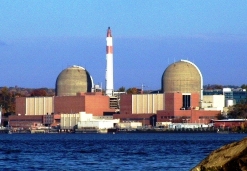Reconsidering nuclear as the earth warms
By Kevin E. Foley
In the geographic shadow (or evacuation zone) of Indian Point Energy Center on a day filled with ominous media headlines — 2014 was the warmest year on record, much ocean life faces extinction — the Depot Docs group screened a film two weeks ago (Jan. 16) guaranteed to raise hackles, stimulate debate and add to anxiety.
Pandora’s Promise, a documentary directed by veteran filmmaker and Rhinebeck resident Robert Stone, embraces the use of nuclear power, the new advanced kind, as a necessary, even desirable response to the threat presented by global warming. The nuclear power process, we are told, does not release atmosphere-warming carbon dioxide, as do fossil fuels such as coal and oil. Of course some other problems can occur, but they are largely dismissed in this throw-a-brick-through-the-window-of-antinuclear-thinking argument.
The possibility that the film and the debate afterward would generate sparks and perhaps shards of enlightenment filled the Depot Theater that night to overflowing.
The nearly two-hour work, which first opened in June 2013, chronicles the conversions of several heretofore antinuclear die-hard environmentalists into advocates for the worldwide building of nuclear power plants to stem the rising temperature levels of the earth’s atmosphere while meeting increasing demand for electric power. Sharply produced with warm portraits of sincere individuals discussing their transformations in genuine if not always persuasive terms, the film tries to answer the how and why they have come to see the light at the end of a centrifugal tunnel as the answer to a vexing environmental dilemma.
The more or less first half of the film introduces us to the leading environmentalists and allows them to describe their journeys toward a new way of seeing how upgraded nuclear power with newer, more efficient delivery and greater safety protections — new plants will shut themselves down, removing human error from the equation — with a benign effect on the atmosphere. We also meet some nuclear engineers describing how much better the technology (soon to be available) has gotten.

Along the way, we are told that the nuclear plant incidents (accidents? disasters?) at Chernobyl (Ukraine), Three-Mile Island (Pennsylvania) and Fukushima (Japan) can all be explained from a perspective that seeks to describe the unique circumstances of each situation and minimize the actual loss of life, damage to property and effects of ongoing radiation. A pocket-sized device for radiation measurement is deployed in real time to demonstrate that the naturally occurring radiation in some parts of the world is greater than at any of the now defunct sites. No one is seen questioning this technique and no one is asked to affirm the scientific certainty of the claim.
From the outset, the filmmaker makes clear that his protagonists’ arguments are close to irrefutable. To drive his point home, he bathes his stars in frames of careful light or in carefully chosen settings while antinuclear advocates are ridiculously positioned as fringe nuts misinformed and ill mannered. The absence of credible (dare we say scientific) counterargument is a further weakness in the film.
For Stone, the film is a journey he said he went on without thinking beforehand he would find so many environmentalists rethinking nuclear. And he said during the discussion that many climate scientists are becoming more open to considering the advantages of nuclear power generation.
The end of the film builds momentum and advocacy for nuclear power much like an extended commercial or business opportunity presentation.
Still, when post-film debate moderator, New York Times digital writer and local resident Andrew Revkin asked the audience if anyone’s needle had moved on the subject, perhaps a third or more of the audience’s hands went up. Heartfelt and seemingly credible propaganda can open minds to new possibilities. In that sense Pandora’s Promise — Revkin suggested it offered “a jog to the system” — has a role to play in stimulating how we think about energy production as we face global warming.
“This film is a product of desperation. We are grasping at whatever straws are put in front of us. It is a bit of a fairy tale,” declared Paul Gallay, executive director of Riverkeeper, a well-known Hudson Valley environmental group fighting the re-licensing of the Indian Point plant.
Throughout the discussion, Gallay reiterated his point that the promise of better, safer nuclear energy is an old one never kept but always looming on the horizon. “Every time there is a new design they say it will be the best,” he said. For Gallay, who hastened to add that his group is not completely antinuclear but definitely anti–Indian Point, the full embrace of great energy efficiency and storage (better batteries) and the serious and broad deployment of renewable energy systems — such as solar and wind — is the key to addressing global warming.

Stone acknowledged the attractiveness of alternative energy projects driven by localized initiatives such as solar power for homes. “But you need a supersmart national grid to meet energy demand,” he said. “We’re going to have to tolerate things we don’t like,” he said at another point.
Revkin has written often on his NYT DotEarth blog and spoken locally before on global energy demand. He maintains that when you consider American green initiatives against the backdrop of the rising economies of the world in Asia, South America and Africa, they pale in comparison to the future energy demand these countries will create. “Solar and wind are such a low base on which to build,” he said.
Revkin also pointed out that scarce research dollars for energy solutions hold back answers for global warming. He asserted that U.S. defense research is funded at between $90 to 100 billion, cancer research at $40 billion and energy research including nuclear at only $2 to 3 billion.
On Indian Point, Gallay spoke of earthquake vulnerability, rising cancer statistics, the storage of waste from the production of energy and the tragic possibilities of an accident. But Stone replied, “Any renewable energy used to replace the loss of Indian Point doesn’t go to replace oil and coal somewhere else.” He said further if any of the agencies involved, the Nuclear Regulatory Commission, the Department of Energy and the Environmental Protection Agency, said to shut Indian Point he’d agree. “But they haven’t,” he said.
In the film and later, Stone held up France as a paragon of environmental virtue with its commitment to nuclear and, according to Stone, the cleanest air in Europe. Gallay countered that the leading industrial country in Europe, Germany, was moving in the opposite direction, abandoning nuclear for solar, wind and other alternatives in the aftermath of Fukushima.
Toward the evening’s end, Revkin again asked for a show of hands in support of President Obama’s stated policy to include nuclear energy as part of the country’s energy policy. Maybe a fifth to a quarter of hands rose. Nuclear apparently has a way to go in winning minds let alone hearts.
